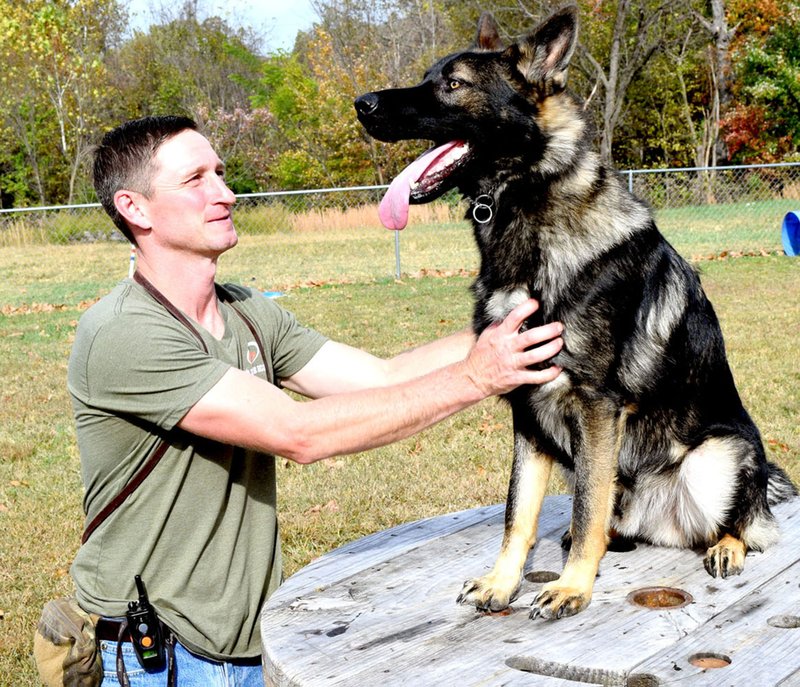DECATUR — Located about five miles east of Decatur on Arkansas Highway 102 is a place dedicated to training of service and family canines. The Ozark Canine Academy sits on 45 acres of the most picturesque land in Northwest Arkansas.
Mike Wood, owner and operator, and his partner Josh Wooten opened the training center in 2014 to train service dogs for a wide variety of applications, including seeing eye, search and rescue and law enforcement.
As early as 300 B.C. dogs were used in battles as sentinels or patrol, some were used to take down enemy troops and force foreign invaders to retreat. Attila the Hun took canines into battle.
In St. Milo, France, around 1,300 dogs were first used as civilian patrol. The first canine training school on record was established in Ghent, France, in 1895. This school was the first to train dogs for police work. This school set the standards for the use of dogs as a tool for law enforcement. By 1902 the Ghent program had a complement of 120 handlers and 60 dogs. As early as 1907, dogs were used in New York City on the beat.
Wood and Wooten met while serving in the U.S. Army during the early 2000s. They forged a lasting friendship that would eventually bring them to the Decatur area. After completing the Army's Ranger indoctrination program, the pair went on to serve in the Special Operation Unit, 2nd Battalion of the 75th Ranger Regiment. Wood served for seven years, completing four combat deployments, while Wooten served 10 years, completing 12 combat deployments.
Wood's love for dogs goes all the way back to his boyhood. He always dreamed of owning his own kennel and being a trainer. After high school, Wood went to work for a local breeder. Following his dream took him into the military where he was assigned to be a canine handler for his Ranger Regiment and trained military working dogs. After leaving the military, Wood's dream became a reality when he opened the Ozark Canine Academy. He holds several certifications in dog handling and training of service animals.
Walking into the Ozark Canine Academy's kennel building, one would expect to see German shepherds and labrador retrievers, the typical service animals. Instead the kennel is filled with a wide variety of canines, including collies, terriers, pit bulls and even a poodle. But more than training service dogs, Wood's facility also trains family pets. Their mission: "to incorporate dogs into family life by working with each family to learn its lifestyle so they can provide the needed training for the family pet so they participate seamlessly" (www.ozarkcanine academy.com).
Off from the main kennel building is a compound Wood uses as a training center. Its fenced-in area includes an obstacle course comprised of ramps, barriers, posts and a 3-foot high tube through which the dogs must crawl. But this course is more than navigating the obstacles, it's about communication.
"Every dog has a different way of seeing and thinking," Wood said. "It's not so much about the obstacles as it is communication and positive guidance. The dog can make the decision to tackle the obstacle, and it is a good one even if they don't complete it."
Wood works on the same basic principles of positive reinforcement that are found in early child development training. A positive response yields a reward, while a negative one yields a punishment. With the rewards comes positive reinforcement. The end result is a dog that, when pressed into service, performs his task without hesitation.
Wood is currently working on clearing and constructing a 35-acre situational training area for his working dogs to gain experience in search and rescue as well as other service applications. A target is placed deep inside one of the facility's heavily wooded areas and the trainer puts the dog into a search mode.
"We are building trails and clearing areas as we go," said Wood. "We have magical little places throughout the hills and valleys where things align, like a park where we can train the dogs to handle any situation that might arise in that setting."
Once the dogs complete their training, they become, not only a loving asset for families, but a valuable tool for law enforcement, search and rescue and military services.
Over the years, an unbreakable bond between handler and animal has resulted in several service dogs losing their lives in the line of duty. In 2015, a total of 19 K9 officers were killed either protecting their handlers or going after suspects. This has prompted several new laws that impose strict penalties for anyone intentionally killing these service animals. This has also prompted several local, state and federal law enforcement agencies and military organizations to create special awards for dogs killed in the line of duty.
The loving care that Wood and Wooten put into their training regimen helps to develop a dog that is a productive part of today's society, whether sleeping near a fireplace at home or patrolling city streets. Thanks to the work of Ozark Canine Academy and similar K9 training operations, this world is a safer place to work and play.
For more information on the services that Mike Wood and Josh Wooten provide for dogs, visit www.ozarkcanineacademy.com.
General News on 11/23/2016

